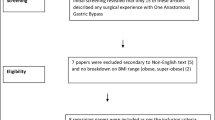Abstract
Background
Gastric bypass can be technically challenging in super–super obese patients. Both Roux-en-Y gastric bypass (RYGB) and one anastomosis (mini) gastric bypass (OAGB/MGB) have been described in these patients, but direct comparisons are lacking. The purpose of this study was to compare the early outcomes with these two procedures in patients with body mass index (BMI) of ≥60 kg/m2 in our unit.
Methods
We identified all super–super obese patients who underwent either OAGB/MGB or RYGB from our prospectively maintained database. Information was also obtained from the case notes and from hospital computerized records. We obtained data regarding patient demographics, operative details, complications, and weight loss, in both groups, and compared them using standard statistical methods.
Results
This study compares our results with 19 OAGB/MGB and 47 RYGB super–super obese patients performed in our unit between October 2012 and June 2015. OAGB/MGB group patients had a significantly higher weight and body mass index. There was no mortality or major complication in either group. There were two late complications in the OAGB/MGB group compared to six in the RYGB group. One patient in the OAGB/MGB group needed conversion to RYGB for persistent reflux symptoms. OAGB/MGB patients achieved a significantly higher EWL of 70.4% at 2 years compared to 57.1% in the RYGB group. The difference between TWL of 44.4 and 33.4%, respectively, was also significant at 2 years. TWL of 43.0 and 29.3%, respectively, in OAGB/MGB and RYGB groups at 18 months was also significantly different, but the difference in EWL at 18 months did not reach significance.
Conclusion
One anastomosis (mini) gastric bypass yields superior weight loss at 18 and 24 months in comparison with Roux-en-Y gastric bypass in patients with BMI of ≥60 kg/m2. Findings need confirmation in larger randomized studies.
Similar content being viewed by others
Abbreviations
- RYGB:
-
Roux-en-Y gastric bypass
- OAGB/MGB:
-
One anastomosis (mini) gastric bypass
- BMI:
-
Body mass index
- LSG:
-
Laparoscopic sleeve gastrectomy
- LAGB:
-
Laparoscopic adjustable gastric banding
- GORD:
-
Gastroesophageal reflux disease
- EWL:
-
Excess weight loss
- TWL:
-
Total weight loss
- BP:
-
Bilio-pancreatic
- T2DM:
-
Type 2 diabetes mellitus
References
Angrisani L, Santonicola A, Iovino P, Formisano G, Buchwald H, Scopinaro N (2015) Bariatric surgery worldwide 2013. Obes Surg 25(10):1822–1832
Regan JP, Inabnet WB, Gagner M, Pomp A (2003) Early experience with two-stage laparoscopic Roux-en-Y gastric bypass as an alternative in the super–super obese patient. Obes Surg 13(6):861–864
Mehaffey JH, LaPar DJ, Turrentine FE, Miller MS, Hallowell PT, Schirmer BD (2015) Outcomes of laparoscopic Roux-en-Y gastric bypass in super-super-obese patients. Surg Obes Relat Dis 11(4):814–819
Villamere J, Gebhart A, Vu S, Nguyen NT (2014) Body mass index is predictive of higher in-hospital mortality in patients undergoing laparoscopic gastric bypass but not laparoscopic sleeve gastrectomy or gastric banding. Am Surg 80(10):1039–1043
Mahawar KK, Jennings N, Brown J, Gupta A, Balupuri S, Small PK (2013) “Mini” gastric bypass: systematic review of a controversial procedure. Obes Surg 23(11):1890–1898
Mahawar KK, Carr WR, Balupuri S, Small PK (2014) Controversy surrounding ‘mini’ gastric bypass. Obes Surg 24(2):324–333
Mahawar K, Kumar P, Carr WRJ, Jennings N, Schroeder N, Balupuri S, Small PK (2016) Current status of mini gastric bypass. J Minim Access Surg. doi:10.4103/0972-9941.181352 Epub ahead of print
Parmar CD, Mahawar KK, Boyle M, Carr WR, Jennings N, Schroeder N, Balupuri S, Small PK (2016) Mini gastric bypass: first report of 125 consecutive cases from United Kingdom. Clin Obes 6(1):61–67
Peraglie C (2008) Laparoscopic mini-gastric bypass (LMGB) in the super-super obese: outcomes in 16 patients. Obes Surg 18(9):1126–1129
Weiner RA, Theodoridou S, Weiner S (2011) Failure of laparoscopic sleeve gastrectomy–further procedure? Obes Facts 4(Suppl 1):42–46
Gonzalez-Heredia R, Sanchez-Johnsen L, Valbuena VS, Masrur M, Murphey M, Elli E (2016) Surgical management of super-super obese patients: Roux-en-Y gastric bypass versus sleeve gastrectomy. Surg Endosc 30(5):2097–2102
Lee WJ, Yu PJ, Wang W, Chen TC, Wei PL, Huang MT (2005) Laparoscopic Roux-en-Y versus mini-gastric bypass for the treatment of morbid obesity: a prospective randomized controlled clinical trial. Ann Surg 242(1):20–28
Lee WJ, Ser KH, Lee YC, Tsou JJ, Chen SC, Chen JC (2012) Laparoscopic Roux-en-Y vs. mini-gastric bypass for the treatment of morbid obesity: a 10-year experience. Obes Surg 22(12):1827–1834
Lönroth H, Dalenbäck J, Haglind E, Lundell L (1996) Laparoscopic gastric bypass. Another option in bariatric surgery. Surg Endosc 10(6):636–638
Lee WJ, Wang W, Lee YC, Huang MT, Ser KH, Chen JC (2008) Laparoscopic mini-gastric bypass: experience with tailored bypass limb according to body weight. Obes Surg 18(3):294–299
Tolone S, Cristiano S, Savarino E, Lucido FS, Fico DI, Docimo L (2016) Effects of omega-loop bypass on esophagogastric junction function. Surg Obes Relat Dis 12(1):62–69
Nergaard BJ, Leifsson BG, Hedenbro J, Gislason H (2014) Gastric bypass with long alimentary limb or long pancreato-biliary limb–long-term results on weight loss, resolution of co-morbidities and metabolic parameters. Obes Surg 24(10):1595–1602
Author contributions
CP and MA collected most of the data and analyzed it. CP also helped with the manuscript writing. KM conceived the idea and wrote most of the manuscript. MB maintains our prospective database and provided some of the data. All authors participated in academic discussions on this topic and contributed to the write-up. All authors have seen the final draft and approve of it.
Author information
Authors and Affiliations
Corresponding author
Ethics declarations
Disclosures
Mr. Parmar, Mr. Abdelhalim, Mr. Mahawar, Ms. Boyle, Mr. Carr, Mr. Jennings, and Mr. Small have no conflicts of interest of financial ties to disclose.
Rights and permissions
About this article
Cite this article
Parmar, C., Abdelhalim, M.A., Mahawar, K.K. et al. Management of super–super obese patients: comparison between one anastomosis (mini) gastric bypass and Roux-en-Y gastric bypass. Surg Endosc 31, 3504–3509 (2017). https://doi.org/10.1007/s00464-016-5376-x
Received:
Accepted:
Published:
Issue Date:
DOI: https://doi.org/10.1007/s00464-016-5376-x




